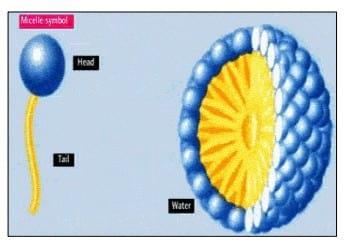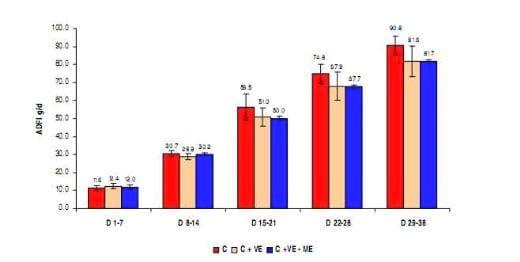Meeting the nutrient needs of modern intensively reared broilers is a challenge to the feed formulators. The high yielding broiler birds require diets with high nutrient density. Commercial feeds are, therefore, often supplemented with fats and oils to achieve the high energetic density. The fats added to the diet enter the gastro-intestinal tract as part of the digesta in rather big coagulated particles. Under the influence of bile salts these fat particles are emulsified into smaller particles. This increases the surface of fat particles, thereby expanding the target area of the lipolytic enzyme lipase. A fat molecule (triglyceride) is composed of a molecule glycerol in which each of the three carbons is linked to a fatty acid. Triglycerides are enzymatically digested by lipase into a monoglyceride and two free fatty acids. At physiological circumstances most of the fatty acids derived after lipase hydrolysis are insoluble. For further transport through the aqueous environment of the intestinal tract, solubilisation of these lipolytic products is required. This is established through the process of micelle formation, which is the aggregation of hydrophobic components (primarily fatty acids) mediated by amphiphatic molecules such as bile salts and monoglycerides.
Figure 1 –Arrangement of fatty acids in a micelle
The process of fat emulsification is the most important step in achieving the maximum metabolizable energy (ME) value from the added fat source. However, secretion of bile and lipase in young chick is always insufficient to get an optimum emulsification and this often results in depressed ME value of the fat added to the diet. To assure that these added fats are absorbed efficiently by the bird’s digestive system one should add emulsifiers.
How do these emulsifiers work and how important are they?
Emulsifiers can support the digestive functionality particularly when fat is added to the diet at a young age. An emulsifier is a blend of a hydrophobic head and hydrophilic tail. The quality of an emulsifier depends on the length of the hydrophilic tail it possesses – a quality which makes the emulsifier more soluble in the aqueous medium of the small intestine and brings it into contact with a greater number of fat molecules and facilitates their digestion and absorption. Soy lecithin, a well known and widely used emulsifier, is highly lipophilic nature, and therefore, dissolves only in the fat fraction. Owing to its insolubility in water, lecithin requires exogenous energy to make it dissolve in water. On the other hand if a water soluble emulsifier is dissolved in water, it will not consume any additional energy to be dissolved in water (Figure 2) and becomes a true nutritional component.
Figure 2- The hydrophilic – lipophilic balance in an emulsifier molecule makes it nutritionally superior
[Source: Do emulsifiers have a place in broiler feeding program? by Sudipto Haldar and Tapan K Ghosh, Feed Quality Conference 2009, Bangkok]
Nutritional emulsifiers in broiler diets – some facts
Effects of nutritional emulsifiers have been tested in broilers through a good number of experiments. The results have been summarized by Smulders (2006). Generally emulsifiers have been found to have a positive effect on feed conversion ratio (FCR) and the growth rates of birds. Supplementation of 500 ppm of nutritional emulsifier to broiler diets is capable of increasing final weight of broilers by 2-5% with a consequent improvement in FCR by 2-4 %. The literature with regards to the effects of nutritional emulsifiers in broilers indicates the total energy content in broiler diets may be reduced by as much 3% when 500 ppm of the nutritional emulsifier is added (Smulders, 2006). Reduction in dietary energy content may result in significant improvement in feed conversion by lowering the feed intake under the influence of nutritional emulsifiers. These improvements in FCR indicate the nutritional emulsifiers compensate for an energy reduction in broiler diets without reducing growth parameters. Therefore, with the current high prices of feed ingredients, nutritional emulsifiers may help in reducing feed costs.
Nutritional emulsifier sustains broiler performance even at a lower plane dietary ME – a practical experience
An experiment was conducted with the hypothesis that the energy value present in a nutritional emulsifier compensates for an energy reduction in broiler diets without impacting the performance traits. The emulsifier tested in the trial was a molecule from the group glycerol polyethylene glycol recinoleate which is a free flowing powder ester of ethylene oxide and recinus oil E484 (Volamel Extra, Nukamel, Belgium). It is hydrophilic in nature and, therefore, dissolves in the aqueous phase of the small intestine. Consequently, unlike conventional emulsifiers, like soy lecithin, it consumes little energy in becoming dissolved by mechanical stirring in the gut – a criteria that qualifies the product to be called as ‘nutritional emulsifier’.
The diets
The experimental diet was corn-soybean based and palm oil was the source of added fat (Table 1). It is generally recommended that an emulsifier should not be solely added to diet but should be thoroughly dispersed in the fat source and the blend heated to achieve maximum emulsification and physiological effects (Dierick and Decuypore, 2004). Accordingly, the emulsifier was first added to the oil and a homogenous blend was made with the help of a mechanical stirrer and the blend was then added over the top of the diet during mixing. It is noteworthy that the diet did not contain any antibiotic growth promoter. Antibiotics mask the action of emulsifiers by destroying the microbial habitat of the gut. Many indigenous bacteria including Lactobacillus, Bifidobacteria, clostridia, enterococci, Bacteroides and Eubacteria catabolize the de-conjugation and de-hydroxylation of primary bile acids (hyocholic acid, chenodeoxycholic acid) into secondary bile acids like hyodeoxycholic acid and lethocholic acid, leading to improved lipid absorption due to less efficient micelles formation. Therefore, addition of antibiotics to the diets may indeed increase fat absorption in the foregut as was found by Young et al. (1963) in chickens and probably through bile catabolism. The diet also did not contain any exogenous lipase. Lipase addition was avoided in anticipation that it may destroy the emulsifier itself during the storage of the diet. Although the diets used in the study was not “energy dense” per se, but the ME content in the VE – ME diet was reduced by 2 %
Table 1 – Composition of experimental diets
Study parameters
The trial was of 38 days duration and was conducted with a flock of 240 ‘as-hatched’ Cobb400 broiler chicks (mean body weight 48.4± 0.4g, obtained 6 h post hatch from a commercial hatchery). The birds were weighed and placed randomly in pens (1.5 m x 1.5 m) on litter floors and were divided into 3 treatment groups control (C, devoid of supplemental emulsifier), control + Volamel Extra (0.25 g kg-1 diet, C + VE) and diet with reduced ME (2%) + Volamel Extra (VE –ME). Each dietary treatment consisted of 8 replicates and there were 10 birds in each replicate. Feed and water was offered ad libitum and sufficient ventilation was provided to the experimental room. However, no attempt was made to control the ambient temperature. As a consequence, the temperature was maintained consistently around 30oC throughout the study period. After the initial recording, body weight was recorded at the end of 21 and 38 days of age. Total pen feed consumption was measured every day and the feed conversion ratio (FCR) was calculated.
Live performance
Final live weight on day 38 increased numerically by ~ 4% in the C + VE group over the control. Supplementation of Volamel Extra sustained live weight and numerically the birds in the VE – ME group had ~ 1% higher body weight than the control group of birds. Improvement in terms of FCR was remarkable when Volamel Extra was added to the diet. FCR in the C + VE group was improved by ~ 14% relative to the control group. Volamel Extra reduced feed consumption by about 9.5 % over that in the control group and this was reflected in the improved FCR. Supplemental emulsifier seemingly elicited an energy sparing effect which could be evidenced from the feed intake value in the VE – ME group. Despite reduction in dietary ME content, the birds in the VE – ME group could mange to meet their energy requirement even at lower plane of feed intake. Consequently, FCR in the VE – ME group was improved by 11 % than that in the control (Table 2). Livability was conspicuously better when dietary ME was reduced in the VE – ME group than the control and even the C + VE groups of birds.
Table 2 - Emulsifier (Volamel Extra, VE) improves live performance of broiler chickens
Level of significance indicated by ** P < 0.01, NS, not significant; Means bearing dissimilar superscripts vary significantly
It is interesting to note that average daily feed intake (ADFI) started decreasing due to added emulsifier from the 3rd week (Figure 3). However, despite reduction in feed intake the birds grew more in the C + VE group probably because the emulsifier facilitated nutrient absorption from the gut more efficiently than that occurred in the control group. The performance of the VE – ME dietary group revealed that the birds could extract greater quantum of nutrients and could sustain their growth rate even when dietary ME level was reduced by 2%. This is quite interesting since the concept of using emulsifiers in broiler diets can be extrapolated towards formulating dietary regimens in tropical countries where heat stress is a severe constraint for efficient broiler production.
Figure 3 – Supplementation of Volamel Extra in diet with concurrent reduction in dietary ME reduces daily feed intake
Dietary ME intake and energy utilization efficiency
Supplementation of Volamel Extra reduced ME intake (P < 0.05) probably as a direct function of feed intake (Figure 4). The birds fed Volamel Extra consumed 7-12% less ME yet they gained greater body weight than the control group. Similarly, when dietary ME content was reduced energy consumption decreased by ~ 13 % in the grower phase although the birds sustained their growth rate. The results indicate that when the birds were exposed to chronic heat stress supplemental emulsifier may be of help in alleviating that stress – probably by enhancing the digestibility and absorption of nutrients. Plausibly, a comparatively lower ME in diet saved unnecessary energy loss (through specific dynamic action of food) and that energy was used in the process of body growth.
Economic efficiency
Dietary emulsifier supplementation had conspicuous economic benefit. The gross economics of feeding was calculated for the present study (Table 3). Feed consumption during the starter and the grower phase was reduced when Volamel Extra was fed to the birds. Feed cost increased marginally when Volamel Extra was added to the control diet. However, this rise in feed cost was compensated when the cost feeding for a single bird was calculated which was ~ 9 % less in the C + VE group than that in the control group. Obviously, this benefit was due to the effect of the supplemental emulsifier which facilitated the birds to grow at a much higher rate relative to the control. The results further indicated that if dietary ME was reduced by 2 % then the feeding economics could be improved further with added emulsifier. It was stated above that addition of Volamel Extra in diet helped the birds to sustain growth rate at par with that of the control group despite reduction of dietary ME. However, the efficiency of ME utilization was higher (P < 0.05) in the VE – ME group than that in the control and this facilitated a better economic return in that group.
Figure 4 – Supplementation of Volamel Extra reduces energy intake and efficiency of ME utilization
Table 3 – Economic efficiency of production improved due to Volamel Extra supplementation
Conclusions
It was concluded from the present study that a nutritional emulsifier like Volamel Extra can give large improvements in broiler performance in terms of body weight gain and FCR. Added emulsifier may improve the efficiency of ME utilization and has energy sparing effect. Thus, nutritional emulsifiers may be included in broiler diets with lower energy density. In other words, the benefits of supplementing broiler diets with nutritional emulsifier may be extrapolated towards formulating dietary regimens for broilers exposed to chronic heat stress- the strategy will conserve the unnecessary loss of ME due to specific dynamic action of energy dense diets and will drive that energy towards production.
References
Dierick, N., Decuypere, J.A. (2004) Influence of lipase and/or emulsifier addition on the ileal and faecal nutrient digestibility in growing pigs fed diets containing 4% animal fat. Journal of the Science of Food and Agriculture 84: 1443-1450. Smulders, D. (2006) Nutritional emulsifiers make most of the feed energy. Feed International (May 2006): 26-29. Young, R, Garret, R., Griffith, M. (1963) Factors affecting the absorbability of fatty acid mixtures high in saturated fatty acids. Poultry Science 42: 1146-1154.















.jpg&w=3840&q=75)